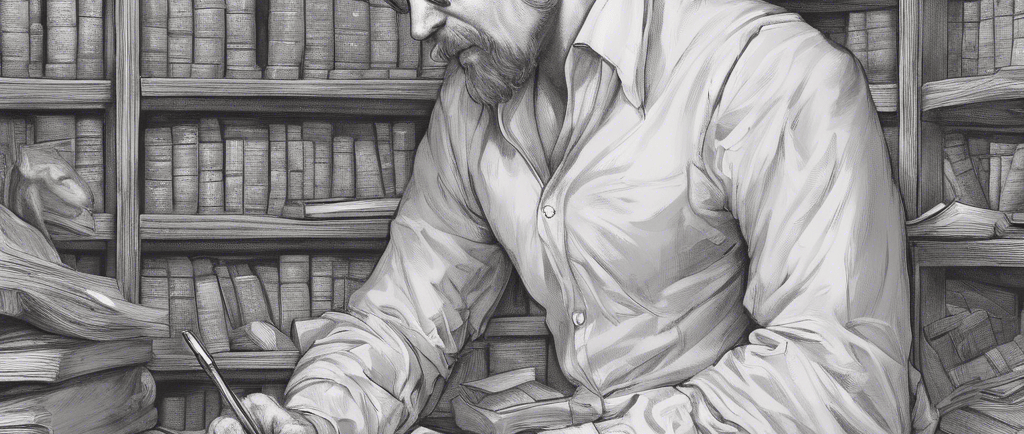10 Classic Diaries in the History of English Literature
WRITER AT WORDHOUSE


Long before the rise of social media, English writers were already leveraging the power of personal narratives to shape their public image and leave a lasting legacy. Diaries, with their intimate and unfiltered accounts of daily life, offered a unique way to connect with readers and share personal insights. Here are ten classic English diaries that have made a significant impact on the literary world:
The Diary of Samuel Pepys (1660-1669): This detailed account of life in Restoration London provides a vivid picture of the Great Plague, the Great Fire, and the social and political landscape of the time.
The Diary of John Evelyn (1641-1706): Evelyn's diary offers a complementary perspective to Pepys', focusing more on the cultural and intellectual life of the period.
The Journal of a Voyage to the South Seas (1767-1771): Captain James Cook's journal of his voyages to the Pacific Ocean is a classic of travel literature and a valuable historical document.
The Diary of a Country Parson (1833-1870): Reverend Robert James William Hamilton's diary provides a glimpse into the life of a rural clergyman in Victorian England.
The Diary of a Nobody (1892-1895): George and Weedon Grossmith's humorous diary of a fictional character, Mr. Pooter, satirizes the aspirations and frustrations of the middle class.
The Diary of a Young Girl (1942-1944): Anne Frank's poignant and powerful diary, written while she was in hiding during the Holocaust, has become a symbol of hope and resilience.
The Diary of Sylvia Plath (1950-1963): Plath's diary offers a raw and intimate account of her struggles with mental illness and her creative process.
The Journal of a Disappointed Man (1835): John Stuart Mill's journal, written during a period of deep depression, explores themes of meaning, purpose, and the human condition.
The Diary of Virginia Woolf (1915-1941): Woolf's journals offer a fascinating glimpse into the mind of one of the most influential writers of the 20th century.
The Diary of a Nobody (1963-1965): This modern-day version of the classic diary series, written anonymously, provides a humorous and insightful account of everyday life.
These diaries demonstrate the enduring power of personal narratives to connect with readers and offer unique perspectives on the world. They serve as a testament to the human desire to document our experiences and share our stories with others
The Diary of Samuel Pepys
Samuel Pepys diary offers an unparalleled glimpse into the vibrant, tumultuous, and often scandalous world of 17th-century England. His meticulous daily entries, written in shorthand, chronicle everything from personal affairs to major historical events.
Pepys' diary begins in 1660, the year of King Charles II's restoration to the throne. As a naval administrator, he was deeply involved in the politics and affairs of the time. His vivid descriptions of London life, including the city's architecture, fashion, and social scene, provide a fascinating portrait of a period marked by significant social and cultural changes.
One of the most dramatic events chronicled in Pepys' diary is the Great Fire of London in 1666. He provides a harrowing account of the fire's destruction, the panic and chaos that ensued, and the efforts to contain the flames. Pepys' personal experiences during this crisis reveal the resilience and adaptability of Londoners in the face of adversity.
Another major event covered in the diary is the Plague of 1665. Pepys' detailed observations of the disease's spread, the public health measures taken, and the impact on London's population offer a valuable historical record of this devastating epidemic.
Beyond these major events, Pepys' diary offers a wealth of insights into the personal lives of individuals, the functioning of government, and the cultural and intellectual trends of the time. His candid observations of the people around him, including his family, friends, and colleagues, provide a sense of intimacy and authenticity that is rare in historical accounts.
The Journals of Virginia Woolf (1882-1941)
A renowned English writer whose modernist novels, such as Mrs. Dalloway and To the Lighthouse left a profound impact on English literature, Woolf began keeping journals as a young woman. Writing in them throughout her life, Woolf shared personal experiences, her thoughts on literature and art, and her reflections on the world around her. Her journal entries provide a unique perspective on the intellectual and cultural climate of the early 20th century, and they offer valuable insights into the mind of one of the most influential writers of her time.
Woolf's journals reveal her deep engagement with literature and her commitment to exploring the complexities of human experience. She writes about her reading, her writing process, and her admiration for other writers, both contemporary and from the past. Her reflections on the nature of creativity and the challenges of being a woman writer are particularly illuminating.
In addition to her literary interests, Woolf's journals provide a window into her personal life. She writes about her family, her friends, and her experiences with mental illness. Her candid discussions of her struggles with depression and anxiety offer a powerful and moving account of her inner life.
The Diary of Anne Frank
This diary is a haunting and deeply moving document that offers a unique perspective on the horrors of the Holocaust. Written by a 13-year-old girl while she was hiding with her family in an attic in Amsterdam, the diary provides a raw and intimate account of her experiences during the Nazi occupation of the Netherlands.
Anne Frank's diary reveals the resilience and spirit of a young girl forced to confront unimaginable hardship. Her vivid descriptions of the cramped quarters, the constant fear of discovery, and the isolation of hiding paint a stark picture of the challenges she faced.
One of the most striking aspects of the diary is Anne's unwavering hope and optimism. Despite the darkness that surrounds her, she maintains a belief in the goodness of humanity and the possibility of a better future. Her reflections on love, friendship, and the importance of individuality offer a powerful counterpoint to the dehumanization and hatred that characterized the Nazi regime.
Samuel Taylor Coleridge (1772-1834)
A pivotal figure in the English Romantic movement, STC is known for his poetry, criticism, and philosophical works. His diary, kept from 1794 to 1804, offers a unique and intimate glimpse into the mind of a major literary figure.
Coleridge's diary entries are filled with his musings on a wide range of topics, including poetry, philosophy, literature, and personal life. He discusses his creative process, his struggles with addiction, and his thoughts on the nature of reality and the human mind. The diary reveals the intellectual depth and complexity of Coleridge's thought, as well as his passion for exploring the boundaries of human experience.
One of the most fascinating aspects of Coleridge's diary is his exploration of the power of imagination. He believed that the imagination was essential to the creation of art and that it could be used to transcend the limitations of the material world. His reflections on the imagination are closely connected to his interest in German philosophy, particularly the works of Immanuel Kant and Johann Gottlieb Fichte.
In addition to his philosophical musings, Coleridge's diary also provides valuable insights into the literary and cultural context of the Romantic era. He discusses his relationships with other Romantic poets, such as William Wordsworth and Percy Bysshe Shelley, and his views on contemporary literary trends.
Sylvia Plath's Diary: A Raw and Intimate Account
Sylvia Plath (1932-1963) was a celebrated American poet whose work often explored themes of mental illness, loss, and the complexities of the human psyche. Plath's diary entries provide a glimpse into the mind of a troubled and gifted individual. She writes candidly about her experiences with depression, anxiety, and suicidal thoughts. Her reflections on her relationships, her creative process, and her struggles to find meaning in life offer a powerful and moving portrait of a complex and vulnerable person.
One of the most striking aspects of Plath's diary is her exploration of the relationship between creativity and mental illness. She often describes how her writing is a way of coping with her pain and finding a sense of purpose. Her diary entries reveal the intensity of her emotions and the depth of her artistic vision.
Plath's diary is a controversial and often disturbing document. It has been criticized for its graphic depictions of violence and self-harm. However, it also offers a valuable and honest account of a life lived on the edge. For many readers, Plath's diary is a testament to the power of the human spirit and a reminder of the importance of mental health
Boswell's Diary: A Window into 18th-Century Life
James Boswell (1740-1795) is primarily remembered for his groundbreaking biography of Samuel Johnson, The Life of Samuel Johnson. However, his personal diary, kept from his youth until his death, offers a fascinating and revealing portrait of his own life and the literary world of 18th-century England.
Boswell's diary is a candid and often humorous account of his experiences, both personal and professional. He writes about his travels, his love affairs, his legal career, and his friendships with literary figures such as David Garrick and Edmund Burke. His diary entries are filled with anecdotes, observations, and reflections on life and society.
One of the most interesting aspects of Boswell's diary is his portrayal of himself. He is both self-deprecating and self-assured, and he is not afraid to admit his flaws and shortcomings. His honesty and candor make him a sympathetic and engaging figure.
Boswell's diary also provides valuable insights into the literary and social scene of 18th-century England. He describes his meetings with famous authors, his attendance at literary salons, and his participation in the intellectual debates of the time. His diary is a rich source of information about the cultural and social history of the period.
The Diary of Dorothy Wordsworth
Dorothy Wordsworth's diary is a valuable resource for understanding the Romantic era and the natural world. Her detailed observations of the Lake District landscape and her reflections on her brother's creative process provide a unique perspective on the literary and cultural scene of the time.
Dorothy Wordsworth's diary entries often capture the beauty and tranquility of the Lake District, a region that inspired her brother's poetry. She describes the changing seasons, the flora and fauna, and the breathtaking scenery that surrounded her. Her vivid descriptions help to transport the reader to this idyllic setting.
In addition to her observations of nature, Dorothy Wordsworth also provides insights into her brother's creative process. She often accompanied him on his walks and listened to him recite his poems. Her diary entries offer a glimpse into the inspiration and challenges that William Wordsworth faced as a writer.
These classic diaries offer a unique window into the lives and minds of some of the most influential writers and thinkers of their time. More than just historical artifacts, they provide invaluable insights into the craft of writing. By studying the style, tone, and voice of these literary giants, aspiring writers can learn how to craft compelling narratives, develop memorable characters, and express their own unique perspectives. Not merely historical documents, these diaries are essential tools for writers seeking to improve their craft and leave a lasting legacy.

Watch for LibroBisa, our close reading of well-read books in Librokoto. Get ready to share your book reviews. Let us experience the impact of these literary gems.

Discover Filipiniana in Librokoto. Engaging and informative reviews accompany our appreciation of many cherished books in the WordHouse Book Shelf.



